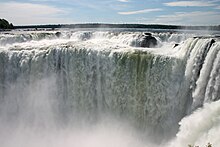Cascavel region is a region of the state of Paraná, in the South of Brazil.
Cities
[edit]- 1 Foz do Iguaçu — main gateway to the Iguaçu Falls and cultural mix with Argentina and Paraguay
- 2 Capitão Leonidas Marques — a tranquil small town in a beautiful rural area of green rolling hills, tobacco plantations, and fruit trees
- 3 Cascavel — it hosts the Cascavel de Ouro racing event, the Coopavel Rural Show, the Livestock Show, and well-known motorsport events, such as Stock Car Brasil
- 4 Guaíra — the Gateway to the Pantanal of Paraná, a corridor of biodiversity with more than 200 islands
- 5 Francisco Beltrão — this town was settled by Italian and German immigrants; its Colonizer Museum tells the history of the occupation and colonization of the town
Other destinations
[edit]- 1 Iguaçu Falls — the world-famous waterfall, and 2 Iguaçu National Park, which has many rare and endangered species of flora and fauna, among them the giant otter and the giant anteater. The clouds of spray produced by the waterfall are conducive to the growth of lush vegetation
Understand
[edit]Get in
[edit]There is an airport with domestic service in Cascavel.
There are good long distance bus connections to the region.
Get around
[edit]Dozens of transport companies provide bus service in the region. Cascavel is a major hub.
See and do
[edit]
You're really here to see the Iguaçu Falls, aren't you? Don't worry: there are lots of trails and viewing points, boat rides and over-flights. While you're there, you can also check out the Parque das Aves (Birds Park) which has 180 species of birds, a butterfly section, and a reptile section. Also nearby is the Itaipu Hydroelectric Plant, the largest electric power generator in the world. It was considered to be one of the seven wonders of the modern world by the American Society of Civil Engineering.
Cascavel hosts major events, such as the Cascavel de Ouro racing event, the Coopavel Rural Show, the Livestock Show, and well-known motorsport events, such as Stock Car Brasil.
In Guaíra, the Cross of the Americas (Centro Náutico Marinas), dated to 1556, is perhaps the oldest mark of Spanish presence in Brazilian territory.


